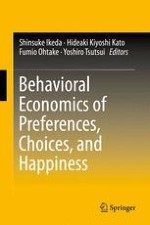2016 | OriginalPaper | Buchkapitel
6. Experiments on Risk Attitude: The Case of Chinese Students
verfasst von : Shunichiro Sasaki, Shiyu Xie, Fumio Ohtake, Jie Qin, Yoshiro Tsutsui
Erschienen in: Behavioral Economics of Preferences, Choices, and Happiness
Verlag: Springer Japan
Aktivieren Sie unsere intelligente Suche, um passende Fachinhalte oder Patente zu finden.
Wählen Sie Textabschnitte aus um mit Künstlicher Intelligenz passenden Patente zu finden. powered by
Markieren Sie Textabschnitte, um KI-gestützt weitere passende Inhalte zu finden. powered by
